

The material quality of stainless steel ball valves plays a crucial role in determining their overall performance and longevity. Stainless steel is widely used for ball valves due to its resistance to corrosion, strength, and durability. However, not all stainless steel is created equal, and variations in material quality can significantly impact how these valves function in different applications. Understanding the relationship between material quality and valve performance is important for choosing the right stainless steel ball valve for specific needs.
One of the main benefits of stainless steel ball valves is their ability to withstand corrosive environments. The corrosion resistance depends heavily on the grade and composition of the stainless steel used. For example, valves made from 304 stainless steel are suitable for many general-purpose applications, offering good corrosion resistance and durability. However, in more aggressive environments, such as chemical processing or marine applications, stainless steel grades like 316, which contain higher amounts of molybdenum, provide enhanced resistance against corrosion and pitting. Therefore, selecting the appropriate stainless steel grade directly affects the valve’s service life and reliability.
The mechanical properties of stainless steel, such as tensile strength and hardness, also influence valve performance. Higher quality materials with consistent chemical composition and proper heat treatment tend to offer better strength, which improves the valve’s ability to handle pressure and mechanical stress. Valves made from lower-quality stainless steel may deform or fail under pressure, leading to leaks or breakdowns. Thus, material quality ensures that stainless steel ball valves can maintain tight sealing and operational integrity over extended periods.
Material quality also impacts the valve’s resistance to wear and abrasion. In applications where the valve is frequently operated or exposed to abrasive fluids, the stainless steel’s surface finish and hardness become critical. A smooth, well-finished surface reduces friction and wear on the ball and seats, helping maintain smooth operation and reducing maintenance needs. Stainless steel with impurities or poor finishing can cause premature wear, affecting the valve’s sealing capability and causing operational issues.
The manufacturing process is closely related to material quality. Reliable stainless steel ball valve manufacturers use high-quality raw materials and precise fabrication techniques to produce valves that meet industry standards. Proper welding, machining, and finishing help maintain the integrity of the stainless steel and prevent weaknesses that could affect performance. Valves produced with inferior materials or poor manufacturing may suffer from defects such as cracks or uneven surfaces, leading to failure under working conditions.
Temperature resistance is another aspect influenced by the material quality of stainless steel ball valves. Stainless steel generally performs well at a wide range of temperatures, but specific grades vary in their ability to maintain strength and corrosion resistance under extreme heat or cold. Selecting a stainless steel ball valve made from suitable material ensures stable performance even in challenging temperature environments.
The material quality of stainless steel ball valves directly affects corrosion resistance, mechanical strength, wear resistance, and temperature tolerance. These factors determine how well a valve performs in its intended application and how long it will last without failure. When choosing stainless steel ball valves, it is essential to consider the grade and quality of the material to match the operational demands. Doing so will contribute to reliable valve function, reduced maintenance, and overall system efficiency.

